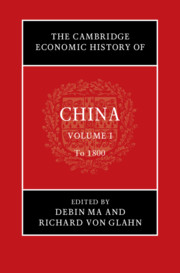Book contents
- The Cambridge Economic History of China
- The Cambridge Economic History of China
- The Cambridge Economic History of China
- Copyright page
- Contents
- Figures
- Maps
- Tables
- Contributors to Volume I
- Acknowledgments
- Note on Citations
- Introduction to Volume I
- Part I Before 1000
- Interlude
- Part II 1000 to 1800
- 7 Ecological Change and Resource Constraints
- 8 Population Change
- 9 Public Finance
- 10 Political Economy
- 11 Law and the Market Economy
- 12 Property Rights and Factor Markets
- 13 The Rural Economy
- 14 Cities and the Urban Economy
- 15 The Monetary System
- 16 Merchants and Commercial Networks
- 17 Foreign Trade
- 18 Production, Consumption, and Living Standards
- Bibliography of Primary Works Cited
- Index
- References
14 - Cities and the Urban Economy
from Part II - 1000 to 1800
Published online by Cambridge University Press: 07 February 2022
- The Cambridge Economic History of China
- The Cambridge Economic History of China
- The Cambridge Economic History of China
- Copyright page
- Contents
- Figures
- Maps
- Tables
- Contributors to Volume I
- Acknowledgments
- Note on Citations
- Introduction to Volume I
- Part I Before 1000
- Interlude
- Part II 1000 to 1800
- 7 Ecological Change and Resource Constraints
- 8 Population Change
- 9 Public Finance
- 10 Political Economy
- 11 Law and the Market Economy
- 12 Property Rights and Factor Markets
- 13 The Rural Economy
- 14 Cities and the Urban Economy
- 15 The Monetary System
- 16 Merchants and Commercial Networks
- 17 Foreign Trade
- 18 Production, Consumption, and Living Standards
- Bibliography of Primary Works Cited
- Index
- References
Summary
While China’s rural economy predominated during the imperial era, some of the world’s largest cities were part of the Chinese landscape. From the Song dynasty (960–1279) onward, the number of cities and towns rose, the urban population expanded, and the urban sector of the economy became a significant indication of the wealth and prosperity of the Chinese empire. Even though large cities such as Chang’an and Luoyang had existed both before and during the Tang dynasty (618–907) and featured sites of production and services, they were founded and functioned primarily as political capitals. In the Song era an extensive array of types of cities besides capitals – maritime ports, provincial transport hubs, manufacturing and commercial centers – flourished as trade and cultural metropoles. Chinese cities took on a different configuration during the Song – one may speak of a “new urban paradigm”: in contrast to the cities of the Tang era with their enclosed wards, gridiron streets, tightly controlled markets, and sharp hierarchical social structure, the Song-era city was shaped by mercantile society and managed by pragmatic bureaucrats.
Keywords
- Type
- Chapter
- Information
- The Cambridge Economic History of China , pp. 522 - 559Publisher: Cambridge University PressPrint publication year: 2022
References
Further Reading
- 1
- Cited by



